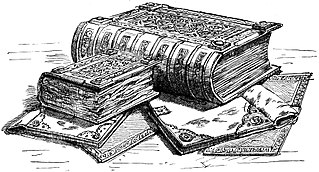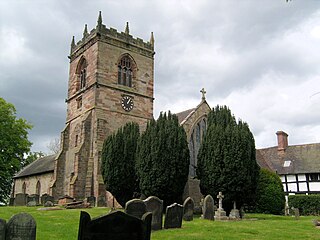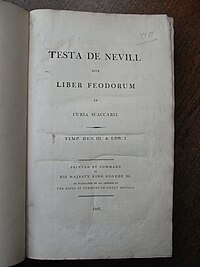
Domesday Book – the Middle English spelling of "Doomsday Book" – is a manuscript record of the "Great Survey" of much of England and parts of Wales completed in 1086 at the behest of King William I, known as William the Conqueror. The manuscript was originally known by the Latin name Liber de Wintonia, meaning "Book of Winchester", where it was originally kept in the royal treasury. The Anglo-Saxon Chronicle states that in 1085 the king sent his agents to survey every shire in England, to list his holdings and dues owed to him.

A fief was a central element in medieval contracts based on feudal law. It consisted of a form of property holding or other rights granted by an overlord to a vassal, who held it in fealty or "in fee" in return for a form of feudal allegiance, services, and/or payments. The fees were often lands, land revenue or revenue-producing real property like a watermill, held in feudal land tenure: these are typically known as fiefs or fiefdoms. However, not only land but anything of value could be held in fee, including governmental office, rights of exploitation such as hunting, fishing or felling trees, monopolies in trade, money rents and tax farms. There never existed a standard feudal system, nor did there exist only one type of fief. Over the ages, depending on the region, there was a broad variety of customs using the same basic legal principles in many variations.

In medieval and early modern Europe, a tenant-in-chief was a person who held his lands under various forms of feudal land tenure directly from the king or territorial prince to whom he did homage, as opposed to holding them from another nobleman or senior member of the clergy. The tenure was one which denoted great honour, but also carried heavy responsibilities. The tenants-in-chief were originally responsible for providing knights and soldiers for the king's feudal army.
Seisin denotes the legal possession of a feudal fiefdom or fee, that is to say an estate in land. It was used in the form of "the son and heir of X has obtained seisin of his inheritance", and thus is effectively a term concerned with conveyancing in the feudal era. The person holding such estate is said to be "seized of it", a phrase which commonly appears in inquisitions post mortem. The monarch alone "held" all the land of England by his allodial right and all his subjects were merely his tenants under various contracts of feudal tenure.

Knight-service was a form of feudal land tenure under which a knight held a fief or estate of land termed a knight's fee from an overlord conditional on him as a tenant performing military service for his overlord.
A bumbulum, or bombulum, was a musical instrument described in an apocryphal letter of St. Jerome to Caius Posthumus Dardanus, and illustrated in a series of illuminated manuscripts of the 10th to the 11th century, together with other instruments described in the same letter. These are the Psalter of Emmeran, 10th century, described by Martin Gerbert, who gives a few illustrations from it; the Cotton manuscript of Tiberius C. VI in the British Museum, 11th century; the famous Boulogne Psalter, A.D. 1000; and the Psalter of Angers, 9th century.
Arrentation, in the forest laws of England, is the licensing an owner of land in a forest, to enclose it with a small ditch and low hedge, in consideration of an annual rent.
Roland the Farter was a medieval flatulist who lived in twelfth-century England. He was given Hemingstone manor in Suffolk and 30 acres of land in return for his services as a jester for King Henry II. Each year he was obliged to perform "Unum saltum et siffletum et unum bumbulum" for the king's court at Christmas.
The Red Book of the Exchequer is a 13th-century manuscript compilation of precedents and office memoranda of the English Exchequer. It contains additional entries and annotations down to the 18th century. It is now held at The National Archives, Kew, London. It takes its name from its red leather binding, which distinguishes it from the related and contemporary, but smaller, Black Book of the Exchequer.
Liber feudorum may refer to:

Lapley Priory was a priory in Staffordshire, England. Founded at the very end of the Anglo-Saxon period, it was an alien priory, a satellite house of the Benedictine Abbey of Saint-Remi or Saint-Rémy at Reims in Northern France. After great fluctuations in fortune, resulting from changing relations between the rulers of England and France, it was finally dissolved in 1415 and its assets transferred to the collegiate church at Tong, Shropshire.

Sir Henry Churchill Maxwell Lyte was an English historian and archivist. He served as Deputy Keeper of the Public Records from 1886 to 1926, and was the author of numerous books including a history of Eton College.

Feudalism as practiced in the Kingdoms of England during the medieval period was a state of human society that organized political and military leadership and force around a stratified formal structure based on land tenure. As a military defence and socio-economic paradigm designed to direct the wealth of the land to the king while it levied military troops to his causes, feudal society was ordered around relationships derived from the holding of land. Such landholdings are termed fiefdoms, traders, fiefs, or fees.
An Inquisition post mortem is an English medieval or early modern record of the death, estate and heir of one of the king's tenants-in-chief, made for royal fiscal purposes. The process of making such inquisition was effected by the royal escheators in each county where the deceased held land. The earliest inq.p.m. was made in 1236, in the reign of King Henry III (1216–1272), and the practice ceased c. 1640, at the start of the English Civil War, and was finally abolished by the Tenures Abolition Act 1660, which ended the feudal system.
The Record Commissions were a series of six Royal Commissions of Great Britain and the United Kingdom which sat between 1800 and 1837 to inquire into the custody and public accessibility of the state archives. The Commissioners' work paved the way for the establishment of the Public Record Office in 1838. The Commissioners were also responsible for publishing various historical records, including the Statutes of the Realm to 1714 and the Acts of Parliament of Scotland to 1707, as well as a number of important medieval records.
John Devereux of Bodenham and Decies was an Anglo-Norman nobleman living during the reigns of King John and Henry III of England. The Devereux were a prominent knightly family along the Welsh Marches during the thirteenth century, and John Devereux was a key member of the retinue of Richard Marshal, 3rd Earl of Pembroke, and companion of Walter III de Clifford, Baron of Clifford.
Walter Devereux of Bodenham and Bromwich was an Anglo-Norman knight and sheriff of Herefordshire living during the reigns of Henry III of England and Edward I of England. The Devereux were a prominent family along the Welsh Marches during the thirteenth century, and integral to the control of this region during the Second Barons' War.
Nicholas Devereux of Chanston (Vowchurch) was an Anglo-Norman nobleman living during the reigns of John and Henry III of England. The Devereux were a prominent knightly family along the Welsh Marches during the thirteenth century, and Nicholas Devereux was a key member of the retinue of Walter de Lacy, Lord of Meath.
Nicholas Devereux II of Chanston (Vowchurch) was an Anglo-Norman nobleman living during the reigns of Henry III of England. The Devereux were a prominent knightly family along the Welsh Marches during the thirteenth century, and Nicholas would play an integral role in attempts to control the Welsh Marches during the thirteenth century.
Hugh Devereux of Chanston (Vowchurch) (c. 1245 – c. 1307) was an Anglo-Norman nobleman living during the reign of Edward I of England. The Devereux were a prominent knightly family along the Welsh Marches during the thirteenth century, and Hugh played an integral role in attempts to control the Welsh Marches.









